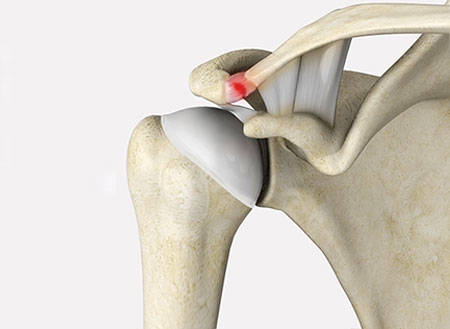As football season forges onward, shoulder injuries of all kinds persist. Whether it be from blocking, tackling, or being tackled, the shoulder is often put in positions of compromise during a football game. One fairly common shoulder injury is a sprain of the acromioclavicular (AC) joint.
The AC joint is the only bony articulation that connects the arm to the trunk of the body. This joint is where the collarbone (or clavicle) joins the acromion of the scapula. The remainder of the arm’s connection to the body is soft tissue including the ligaments that specifically stabilize the AC joint itself. If this joint and surrounding soft tissue is injured, it can significantly impact the function of the arm in terms of strength, motion, and stability.
This injury typically requires a fairly significant trauma directly to the shoulder such as a fall or direct blow. AC sprains are often accompanied by a noticeable and palpable prominence at the AC joint as well as point tenderness, swelling, and shoulder discomfort with loss of function.
The appropriate treatment of this injury depends on the severity of the sprain. AC sprains are often called separations, and they are graded by the severity to which the clavicle has separated from the acromion. The rating system ranges from a grade 1 sprain being the least problematic to a grade 6 sprain being the most severe. In a grade 1 sprain, the ligaments are still intact, and the joint has not physically separated. A grade 2 sprain involves rupture of the AC ligament. Grade 1-2 sprains do not warrant surgical management. A grade 3 involves rupture of both the AC and CC (coracoclavicular) ligaments that result in visible separation of the bones and surgical management thereof can vary based on the patient’s age, hand dominance, and activity level. Grades 4-6 are distinguished by the degree to which the bones are separated and the direction of the displacement. Surgical management is recommended for these injuries.
Most AC joint sprains are effectively treated non-operatively with rest, anti-inflammatory medications, and sling use while the injured tissues heal. Typically patients are feeling better after 6-8 weeks of relative rest depending on the severity of the separation. Sometimes physical therapy is recommended to restore proper shoulder mechanics. One might be left with a visible bony prominence, but this doesn’t typically result in any loss of function.
For the more severe sprains, surgical management to stabilize the joint with hardware is necessary for restoration of function. Sometimes, a repair of soft tissue using a graft is also warranted to further stabilize the joint. The surgery is minimally invasive, but is most typically done under general anesthetic. The hook plate used for fixation that our surgeons prefer is also not permanent. It requires surgical removal about three months after the initial procedure. The motion limitations in the interim are significant. Oftentimes, physical therapy is necessary with surgical management as well.
Regardless of whether your shoulder injury was sustained playing football, riding a dirtbike, or rock climbing, we are here to help!
This blog is written by one of our very own-Morgan. She is a certified athletic trainer working in our clinic with our providers each and every day. She obtained a bachelor's degree in athletic training from Carroll University in Waukesha and a master's degree in Kinesiology from Michigan State University.

